|
This, as you'll soon gather if you skim down the page, is one of our longer reviews. The Long Good Friday is being released by Arrow Video in two separate editions, as a two-disc DVD/Blu-ray Steelbook and later as a six-disc DVD/Blu-ray limited edition that includes Neil Jordan's Mona Lisa complete with a separate disc of extra features unique to that version. The review below is for the Blu-ray in the Steelbook edition and the extra features covered include only those that you'll find on that release.
This is a two-person review. Camus provides an overview of the film and its qualities, and Slarek then examines specific aspects in detail. Following this there is a joint piece on elements that would act as spoilers for first timers, so we've clearly flagged as such to allow you to bypass it if you choose.
And so to the review(s).
"Time Out (London Listings and Review Weekly) said it was wonderful when it
came out. And then the editor changed, right? He said it was a sack of shit.
And that was in the face of all his readers saying it was the greatest, you know." |
Producer Barry Hanson, interviewed by Mark Webster |
It's always amazed me that very broadly speaking, in cinema, the judgement of genre work can sometimes be culturally attributed; as cliché would have it, we get the best introspection from northern Europe, the best westerns from the U.S., the greatest martial arts flicks from the east and for all your kitchen sink realism you go to the U.K. Of course this is nonsense these days seeing the global picture but in the case of the gangster movie, the U.K. has never scored very high on the 'best of genre' list. But hell, if this country was going to throw up a Godfather, then here it is. The Long Good Friday is a superb example of fine feature film craft in all aspects of production.

The story is satisfyingly complex and, I admit, it took one or two viewings for me to recognise who was who and for all the narrative pieces to click into place (that's more my – at the time – nineteen year old's fault than the movie's). The film presupposes the audience can keep up and that always means the work in question has layers and I do love layers. Having seen it recently for the umpteenth time, I was delighted at how well it's stood up. The narrative is essentially this; London gang leader Harold Shand (Hoskins) has kept the peace (assumedly by violent means) in the capital for a decade. He has ambition and needs funding to develop a Thames side marina project that will rake in millions. He has a chief of police and a councillor in his pocket. Among Harold's nearest and dearest are his wife and partner in all senses, Victoria (Helen Mirren), his trusted aide Jeff (BBC's Casualty's Derek Thompson) and Razors, his bodyguard played by P.H. Moriarty, an actor often hired for presence rather than specific thespianic talent. On the day of the arrival of Mafia dealmakers, Harold's world implodes – I will not spoil anything because foreknowledge is a spoiler even if it's giving away incidents from the start of a movie. Harold has to try and keep the American sweet while trying to figure out who's attacking him and why. The answer to that question is extremely satisfying narratively speaking. Once you've seen the film, look up the original title of the script to see how a writer can spoil his own hard work with just three words on the cover of his screenplay...
The pacing of the movie is brilliantly assured. Editor Mike Taylor's work is exemplary. It's a triumph of structure and there's not a dud scene in the whole running time. It actually gets better the more times you see it. The cuts from and to certain scenes have been meticulously planned. From the bloody results of a fatal stabbing we cut into a church and the victim's position from the previous scene is identically mirrored by the Christ on a crucifix at the extreme left of frame – a subliminal register. I just adore stuff like this. An explosion (exquisitely timed) cuts to Harold making his important speech to his prospective American partners, dramatic irony dripping from the sprockets. The ensuing shot showing Harold talking up London lazily revealing Tower Bridge coming into frame from behind, is also evidence of great creative thinking. One of the things I've come to really revel in these days is seeing proof (not boastful, just subtle) that I'm in the hands of a filmmaker who knows exactly what he/she is doing. There's evidence of that craftsmanship all the way through this particular movie. Fourteen and a half minutes in, there is an exquisite cut from a gruesome crucifixion icon held by a choirboy to Paul Freeman (or his diving double) on top of a swimming pool tower. There's a lot more going on with this cut that at first meets the eye but you'll have to finish watching the whole to appreciate what the director is foreshadowing. The movie has so many aspects to enjoy, I'm just going to barrel through a few of them. I'm certain there will be some crossovers with Slarek but hey, we're writing independently unaware of each other's pieces so let's just trust to luck...
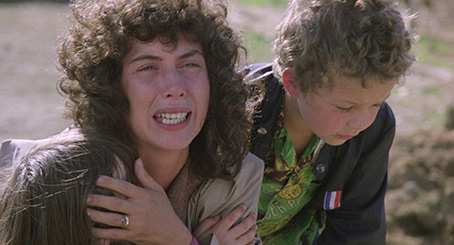
Harold is walking down a narrow yacht walkway trying to impress his new American friend. Mid-speech, he walks into a doorknob and almost spills his champagne. Hoskins doesn't even break character. He just acknowledges the slip up and effortlessly carries on. I'd bet that director Mackenzie deliberately chose that 'mis-take' take for its verisimilitude. In the scene when Mirren admits to Hoskins that she had to tell the Americans everything to keep them in the country, watch Hoskins' face. He pushes her on to the sofa, impotent rage and confusion making him lash out. One sob from Mirren and Hoskins physically transforms himself in the blink of an eye. Mirren is, of course, hugely affecting and it's clear that her harassment of the producer worked in terms of intensifying her role as Harold's equal not his meek moll. But in three small scenes, actress Patti Love is utterly convincing as a bereaved mother. Her emotional collapse in front of Harold at the graveyard is utterly compelling. Harold's confrontation with a character late in the movie is a masterpiece in sustained dramatic irony. Harold is acting a little oddly because we know what he knows and the other character doesn't. This character is squirming on the hook and, as is always the way with charismatic people even if they are monstrous (perhaps especially if they are monstrous), we are on Harold's side.
The electronic score is definitely well set in its era (synths everywhere). But Francis Monkman's terrific score is the spiritual brother to Barry De Vorzon's great work on Walter Hill's The Warriors, a year earlier. But I cannot imagine the movie without that sax led main theme for Harold himself, the swagger and vomit of confidence is just pouring out of that cue. And there's always that staggering final cue as the car roars off... More I won't say here... But I will say that editor Mike Taylor may have shaved a few frames off Hoskins to the cut to black after the final shot – going out on the last drum beat maybe. Yes, I am a pedantic arse but that's OK. I can live with it. But perhaps the editor wasn't responsible for that decision as the music cue dictates the cut and he may well have been working on another project by the time that editorial decision was made. Hey, if I'm carping over frames, we're at a pretty high level of cinematic achievement here.
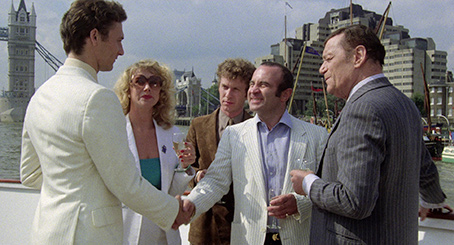
If there is anything else to flag up in a negative way, I guess it's Harold's casual racism, something you have to take on board considering the character's social background and the date of production. It's nice to know his attitudes are now seen as unacceptable. We have come a way, not as long as everyone hopes but a way nonetheless. As I'm supposed to be brief, I'll end on my favourite line from Harold (and there are some juicy ones). Earlier today (and my memory is appalling at most other things) I found myself 'mouthing' the lines in sync with the characters. That says reams about how highly I regard this movie.
As Harold hears his chauffeur has been blown up, he says... "You don't go and crucify people outside a church, not on Good Friday!"
Classic. Enthusiastically recommended.
I previously outlined how I first heard about The Long Good Friday in our tribute to the late Bob Hoskins, when I was given a tantalising hint of the film to come by an actress who had recently worked with and was friends with its lead actor. As a huge fan of Hoskins' work on Dennis Potter's groundbreaking Pennies From Heaven, I immediately wanted to know more, but in these pre-internet days I had to wait until details of the film were reported in the UK trade press. Its first UK showing was at the London Film Festival, but I finally caught it three months later at London's Ritz cinema (now part of the Leicester Square Empire), which for reasons unknown was then a favourite spot for screening movies distributed by Handmade Films, the company formed by George Harrison and Denis O'Brien to finance Life of Brian. It was they who took over the distribution of The Long Good Friday after the bigwigs at Lew Grade's ITC Entertainment were dismayed at what they saw and had set about shortening the film by 25 minutes for television screening and re-dubbing Bob Hoskins' East London accent. A furious Hoskins responded by invoking a clause in his contract that forbade them to replace his voice without his consent, and by whipping up some serious support from a number of theatrical luminaries. A chance meeting between Hoskins and Monty Python's Eric Idle at a party led to Handmade buying the film in its unmolested form, in the process sparing ITC the very public embarrassment of the court case that would otherwise have followed. That's how close we came to seeing one of the all-time great gangster movies shorn of its stronger language and violence and a sizeable portion of its plot, and being subjected to hearing one of our most beloved actors re-voiced by a still unidentified fellow from Wolverhampton.
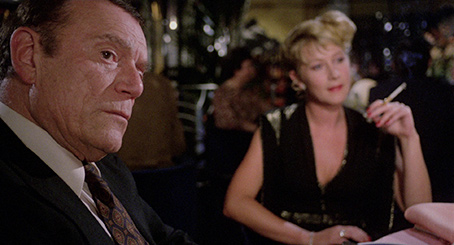
With The Long Good Friday now finding its way onto polled lists of all-time great British films, it's kind of odd to look back at a time when it was dismissed in some quarters as cinematic garbage. The viewing public adored it and a good many reviews were extremely positive, but back in the late 70s and early 80s there was a degree of sometimes infuriatingly snooty critical snobbery when it came anything that could be considered populist entertainment. Now as someone who has little time for so much current mainstream cinema I'm not going to get all superior here, but there were a number of respected organs of the time that seemed to regard it as their duty to crap on just about anything that might find widespread appeal (it's worth remembering that on its initial release, Blade Runner was one of the most critically reviled films of the 1980s and now sits high in polls of key films of the period). With that in mind, consider this conclusion of a brief and scathing review that appeared in the March 1981 issue of Monthly Film Bulletin, the forerunner of the now revered Sight & Sound:
"The Long Good Friday sets out to be a genre movie in a native context, but winds up a blunt, lumpish caricature of one, with all the brassy come-on and hollow ring of something produced for the tourist trade."
Seriously? The tourist trade? Yeah, come to London and experience British corruption, criminality and violence at its finest. Perhaps more telling is the following assessment of the film's finale, particularly the use of quote marks to belittle key elements, a once popular put-down that usually said more about the reviewer than their intended target:
"The sequence sets the seal on two things that have been far from obscure throughout the film: that it is hopelessly in thrall to Bob Hoskins' rhetorical impersonation of East End 'villainy' and that John MacKenzie's [sic] stylistic 'inflections' of the gangster movie are determinedly pitched to the gallery."
You think so? Really? Time, I think, for a couple of short but hopefully relevant anecdotes.
Both of my parents hailed from East London, and I spent my formative years in a town located close enough to it to have had a few small brushes with its organised villainy and those on its manpower periphery. There was a pub in this town that was owned by one of the local gangland kingpins (this was far from unusual in the day), and once a week it was common knowledge that you just didn't go there, as that's when the firm in question gathered for their regular meet. How these guys ever flew under the radar of the police is probably the subject for another story, but when they rolled up in their expensive cars and their Crombie coats there was just no mistaking them. These men (and they were all men) were rarely subtle about their status; indeed they flaunted it. They were hard and they knew it, and genuinely seemed to believe that – to a certain degree at least – they were untouchable. Thus when Harold calls a meeting of the hard men from his firm, I recognised a good many of these guys as the real deal. As it turns out, they were. Something like half the members in that gathering were not professional actors but real life East End villains, who also acted as technical advisers to ensure that every aspect of the film's portrayal of their world was authentic. Note that word, it'll be turning up again.
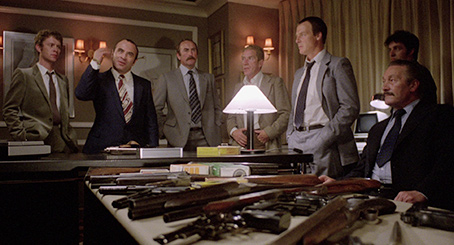
Second recollection. During my art school years (yeah, I was never really cut out to be a gangster, despite my own spotted history of violence), I paid for my materials by working in the kitchen of a local pub restaurant, which at one point was managed by a short and stocky man named Keith whose somewhat shady past was the subject of bar staff gossip. And apart from having a little more hair, he was a dead ringer for Bob Hoskins. He even sounded like him. A thoroughly nice guy for the most part, he nonetheless tolerated no pissing about and came down hard on any aggravation in his bar. I once saw a fight break out ("What did you say about my wife?") in which one guy attacked another with a broken beer bottle. Ignoring all rules of pub management logic, Keith leapt between them, threw them apart and bellowed at both to pack it in. The ferocity behind his actions and his delivery was genuinely startling, and had an immediate effect. At this point he was no longer Bob Hoskins, he was Harold Shand. When I finally saw the film and watched Harold lose his rag I instantly recalled this encounter. Everything about Hoskins' delivery and body language was a mirror image of what I had witnessed. Watching The Long Good Friday for the first time, I didn't have the sense that Hoskins was playing Harold Shand – for me he was Shand.
Hoskins' performance feels so authentic in part because he is able to successfully and convincingly portray Harold both as an ambitious but good humoured businessman and a potentially lethal ball of furious anger. His shock at being told that a car bomb has killed his chauffeur is quickly brought in check as he sharply barks orders to everyone present, then glares out of the window, sucks the blood from a cut finger and snarls to himself, "I'll have his carcass dripping blood by midnight" with a conviction that in real life would have turned me cold with fear. Elsewhere Hoskins adds small bits of business that almost fly under the radar but which ground Harold firmly in the real world. One of my favourites comes when he is waiting for Charlie's arrival and he confidentially asks Jeff to top up the boozy Councillor Harris's glass with Perrier water. As he does so he scratches his left ear with his right hand, a physically awkward motion that might have prompted another director to call for a second take, but there's something so completely natural about it – it feels as much like a nervous tick as it does a response to an itch – that you can see why Mackenzie kept it in. It's something I might catch myself doing in such a situation, and doesn't feel remotely as if it's played for the camera. The film is littered with small moments like this. Caricature? I think not.
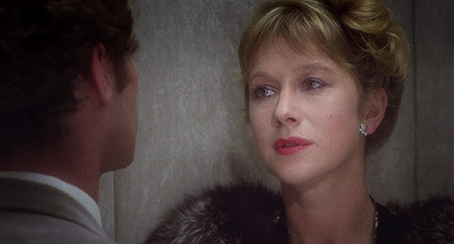
Helen Mirren's stately Victoria also resolutely kicks against the standard gangster movie trope of the bubble-headed moll. Here, almost for the first time that I can recall, the mobster's wife is his equal, not as physically imposing as him but smarter, more refined and more level-headed. But Harold doesn't resent this one iota, and there's never a sense that he feels Victoria is any way better than him (or indeed that she thinks she's better than him). He respects her opinion, and when he feels it's prudent to do so will be guided by her. Harold's no fool – he couldn't have got where he is without being street smart and business savvy – but having someone at his side as intelligent and cultured as Victoria is something he clearly cherishes. How many gangster movies can you say that about? And Mirren is spot on here, her strength and self-confidence evident in almost everything she says and does. Yet under the surface calm sits a woman as human and vulnerable as any of us. This is first visible in her intriguing facial expression following an elevator come-on from someone who should know better, when just for a couple of seconds she seems to be weighing up the pros and cons of something you expect her to automatically reject. But it really hits home later during her only (film) row with Harold after she angrily turns her back on him; when she turns back to face him her expression is one of sheer, uncontrolled terror, as the enormity of what is happening to them and the prospect of her own death really hit home. So convincing and heart-rending is this moment that even after countless viewings it still ties my stomach in knots.
From a modern perspective, Harold's plan for transforming London's stripped out Docklands into a centre for international business looks uncannily on the nose, with the real world Canary Wharf now the embodiment of Harold's Thatcherite dream. As he stands on the bow of his boat addressing the assembled friends and investors, framed against the iconic image of Tower Bridge (you can't help thinking that Harold – or more likely Victoria – specifically chose this route to impress the visiting Charlie), his speech could almost have come from the mouth of an ambitious Tory MP with his eyes on the big bucks. "I'm not a politician!" are his opening words, but there's a sense that if he were around today then he'd be Mayor of London with a huge business empire on the side and would probably have his eyes on the big chair at Number 10.
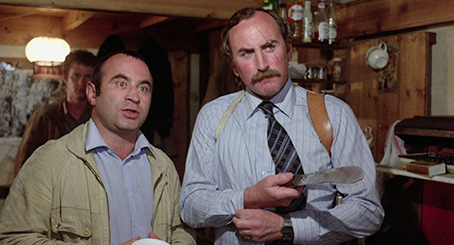
It's hard to be objective here. The Long Good Friday remains a personal favourite and for my money has dated impeccably, in spite of some casual racism that was sadly reflective of its characters and its time. Yet even this element may not be as clear cut as it first seems. When Harold arrives in Brixton, he does nothing to hide his contempt for the local man who initially refuses to provide the required information, prompting Razors to take action that threatens the man's life. "Used to be a nice street, this," Harold says to the man contemptuously. "Decent families. No scum." The racial inference is clear, but is he actually being racist or just verbally belittling the man in a show of power, something he doubtless does on a regular basis to anyone who gets in his way, whatever the creed or colour? As he is driven away after a violent confrontation with a local police informant and with no-one to intimidate, his words take a different tone. "These people deserve something better than this," he says almost to himself as he surveys a neighbourhood. What was that, Harold? Did I detect a touch of empathy there?
Now before we move on we need to flag this...
Seriously, if you've not seen the film and want to go in cold then skip ahead to the technical specs, as I'm going to go on a bit of a spoiler binge here, and that will include a detailed discussion on the ending.
Last chance to check out. Still with me? OK then.
As those who have seen the film will know, the attacks on Harold's organisation and personnel have not been orchestrated by a rival gang but by the IRA, and it was this element that caused the most problems for the film and its makers. Back in the late 70s and early 80s (and beyond into the 90s), the Provisional IRA were still active both in Northern Ireland and on the British mainland, where there was considerable public and particularly political hostility to their cause. Thus any play or film or TV series that even mentioned the IRA in anything but cautionary terms was seen to be walking on dangerous ground. If you want a barometer of just how sensitive the media became on this score, check out a season 3 episode of Star Trek: The Next Generation titled The High Ground, which was first broadcast in America ten years after the release of The Long Good Friday. A story of galactic terrorists who carry out an attack on the Starship Enterprise and hold its crew to ransom, it included a single line of dialogue that dared to suggest that at some future date the Irish Republican fight might result in the reunification of Ireland. The episode was banned from British TV and not screened intact on any UK channel for another sixteen years. And remember, we're not talking Ken Loach's Hidden Agenda here, but an episode of Star Trek.

By incorporating what was perceived to be a real and contemporary threat into the story, screenwriter Barrie Keeffe and director John Mackenzie walked into a small but significant shitstorm. When the film was eventually released, the presentation of IRA operatives as "boogiemen" (MFB review again) drew brickbats from some critical quarters, yet what had so enraged the ITC bigwigs was the suggestion that the IRA were well organised and committed enough to defeat Harold and potentially take control of London's underworld. This, it was deemed, was downright unpatriotic and even seen to be promoting the terrorist cause. Talk about being stuck between a rock and a hard place. But Keeffe and Mackenzie's purpose always seemed clear to me and was confirmed in the documentary included on this disc. What would happen, they pondered, if the forces of capitalistic greed – which right now are in a position of absolute power in the western world – were challenged by the forces of political idealism, if a system based on corruption, organisation and surface stability was pitted against people with no interest in personal advancement and who were prepared to die for a cause? Who do you think would win? We might question Harold's naiveté in not taking the threat as seriously as he should when the pub bombers are identified as Irish, but such is the powerbase that he has created around him. He sees the IRA as just another gang, one that can be defeated in the manner we can presume he employed to muscle his way to the top of the London gangland tree. In his commentary here, director Mackenzie reveals that the small flicker of a smile that crosses Hoskins' face in the memorable finale is likely one of begrudging admiration for his captors, a recognition that an organisation that he so underestimated was actually able to defeat him.
Which brings me to the finale, and what for both of the writers here is quite simply one of the finest and ballsiest endings in modern cinema, as well as being a showcase for the brilliance of Bob Hoskins as a pure film actor. It's now widely recognised as such, but once again came in for a caning in some quarters. Again I have to quote that MFB review, mainly because I still have the magazine in which it appeared:
"Close-ups of Harold reacting with quantities of disbelief, despair and ironic amusement are intercut with close-ups of the gunman – to such an interminable extent that one begins to pray for the trite but merciful release of a freeze frame."
I know we're only talking about differences of opinion here, but so strongly do I feel about this that I'm willing to break my own self-imposed rule of subjectivity and state that in this case I believe the reviewer was wrong. So, so wrong. It's an utterly sublime ending, and I would go on to explain why, had Camus not already done so in far more eloquent fashion in his portion of our tribute to leading man Hoskins, which it makes complete sense to reproduce here:
Gangster crime lord Harold Shand has been throwing his weight around trying to figure out why he is losing men, property and loyalties the only way he knows how – with meat hooks and machetes. In his attempts to set up a deal with the American mafia, he fails to stem the destruction being reigned down on him from an unknown source. The Americans bail, Harold does his 'Brits are best' speech and then leaves the hotel and his car pulls up. As soon as he sits down, the car lurches forward and speeds off. He manages a startled "'Ere, hold up. Where's Victoria?" before he sees a silenced handgun pointed at him from the young man in the passenger seat. As far as I'm concerned, for the next two minutes (with a few intercuts to the man holding the gun) everything is played off a close up of Hoskins. What he does in these two minutes is some of the finest screen acting I'd ever seen. Big and small screen acting should be invisible but there are moments when the visible is just perfect for that time in that narrative. There are very few actors I have seen who have transported me perfectly to a moment's thought in their heads. Mickey Rourke did it in Body Heat and recently Tilda Swinton knocked me out as she withered before Clooney's Michael Clayton in the final scene of the same-named movie. Clooney was great (as the commentary on the disc confirmed) but Swinton's palpable destruction was heart wrenching even though she was the villain. We watched her die inside and I caught all of it from her perfect physical projection.
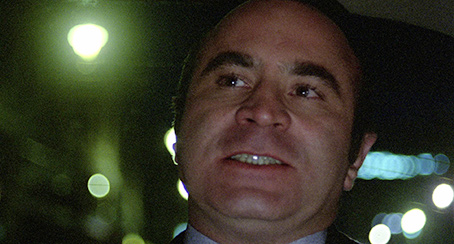
So back to the car. Here's a man who's initially surprised (I mean, where is his wife?), then shocked as he sees her held in obvious distress in another car driving in the opposite direction. He turns to the front and sees the gun trained on him. Harold is a man whose pennies (from heaven?) are now slowly dropping, revelations occurring to him as they come to mind and they are all there in Hoskin's wonderfully expressive face. This is acting out of instinct not out of RADA. There's rage and anger but impotent, both. They slowly subside as he figures out who these people are and then realises that they must have been behind the chaos and that he, Harold, had done nothing to stop them. It hadn't occurred to him during the movie that these people would hold him responsible for the failures of his own men. It's tough being the boss. Then, startlingly, there's a smile, a delicious piece of irony. Once he 'gets it' he knows he's going to get it. The smile reveals to me that he knows he's a dead man. The smile disappears, teeth are gritted and with the merest hint of a deflation, Harold Shand in front of our eyes, breaks. He knows his life is measured in minutes. It's all the stages of death from one of our finest actors; anger, denial, bargaining, depression and acceptance. Absolutely stunning. And all the while the young man smirks at him, gun pointed, while the driver's eyes in the rear view mirror project a cold menace. Just to make Harold a little happier in his final moments, it is James Bond (Pierce Brosnan's first role) who's going to kill him...
Enough said. The Long Good Friday is one of the finest crime thrillers ever made, its London gangster mantle only seriously challenged by the likes of Get Carter and Performance, and despite the brilliance of both films I'd still argue that The Long Good Friday is a purer gangster movie than both. It's a beautifully constructed work, superbly written and performed, and boasts a music score that I knew every note of after seeing it only twice. Going back to it again after a break of a few years, it feels as fresh and vibrant as ever. It also proved to be a watershed moment in British crime cinema, which only a few years down the line would degenerate into a string of mockney gangster wannabes for whom authenticity and restraint would prove alien concepts. The talented John Mackenzie never scored as sublimely again (although check out if you can his searing 1979 TV movie A Sense of Freedom, which told the true story of Scottish gangster Jimmy Boyle), and in spite of landing a number of subsequent prestigious roles, it was only in Neil Jordan's Mona Lisa, itself a London-based gangster story, that Bob Hoskins recreated the electricity and intensity of his performance here. I'm always reluctant to use words like 'masterpiece' when referring to any film, but man, if the shoe fits...
This new restoration, carried out at Deluxe and supervised by James White, was created from the original camera negative and magnetic soundtrack reels. Thousands of instances of dust and dirt were removed, picture stability was improved and audio issues such as pops, clicks and audible buzz were repaired or removed. The restoration was then fully graded under the supervision of the film's director of photography, Phil Méheux. And it looks absolutely gorgeous. I'd seen The Long Good Friday many times before this new Blu-ray arrived on my doormat and tended to think of the film as looking gritty and a little dour, but here it positively sparkles. The picture looks brighter than I've ever seen it – and by that I mean it looks as if a layer of crud has been scraped from its surface and the resulting celluloid given a polish – and the balance of the contrast is when the lighting conditions are favourable (as they often are) is close to sublime. The colours are also richer and deeper than they ever were on DVD, not over-saturated but clean and vibrant and with naturalistic skin tones and crisp black levels, and the level of detail far outstrips its standard definition predecessors. Honestly, it almost feels like a different film. According to Méheux, this is how he always wanted the film to look.
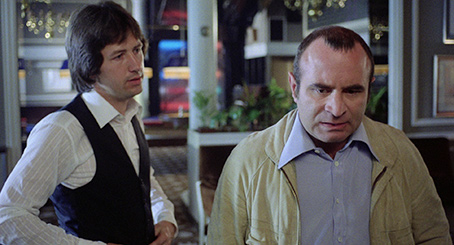
The Linear PCM mono 2.0 track has a slightly narrowed dynamic range, but clarity is first rate and the music, sound effects and dialogue are very cleanly reproduced. There're more going on at the treble end of the spectrum than at the bass, but that's par for the course for a mono track of this vintage. There is, as indicated above, no trace of any damage or other errant noises.
Commentary by John Mackenzie
A port from the Anchor Bay 25th Anniversary DVD release, but now playing at the correct speed (there's no PAL speed-up on Blu-ray), this is a seriously worthwhile grab. Mackenzie is a compelling talker and his almost pause-free commentary is jam-packed with information on the making of the film, from its original inception through its production to the problems with ITC on its completion. There's specific discussion on the casting and work of each of the lead actors, plus info the locations and a number of entertaining anecdotes on the filming of specific scenes. There's also praise for the work of cinematographer Phil Méheux and casting director Simone Reynolds (who's not actually named here), details of changes made to the script, and an admission that he always closes his eyes when he gets to the film's most violent scene – "I hate blood," he confesses. There's loads more here, all of it worth hearing.
Bloody Business: The Making of The Long Good Friday (54:52)
Another useful port from the Anchor Bay release, not least for the contributions of the interviewees around which it is constructed, who include director John Mackenzie, producer Barry Hanson, screenwriter Barrie Keeffe, cinematographer Phil Méheux and actors Bob Hoskins, Helen Mirren and – this surprised me – Pierce Brosnan, who remains very positive about the film and the opportunity it gave him. As with the commentary, all stages of the process of bringing the film to the screen are covered, but here from a wider variety of viewpoints, which also triggers a new set of memories and anecdotes. We also get a breakdown on the shooting of specific scenes, and details of changes made to scripted sequences and why they were altered. As ever, it's Hoskins who proves the most entertaining, particularly his recollection of attending the screening of the version in which his voice had been re-dubbed.
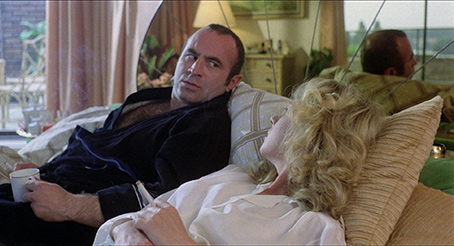
There are three newly shot Interviews:
Barry Hanson (5:40)
The film's producer recalls working with Bob Hoskins on stage in Richard III and ensures us that as a stage actor he was someone who gave an audience confidence. He also touches on the Shakespearean elements of The Long Good Friday.
Barrie Keeffe (8:28)
Screenwriter Barrie Keeffe takes us through how the script came to be (the first draft was, he claims, one of the fastest he ever wrote) and talks about the characters of Harold and Victoria, the casting and performance of Bob Hoskins, and how later EastEnders actress Gillian Taylforth landed a role intended for her sister.
Phil Méheux (3:18)
A very brief chat with the film's director of photography in which he recalls being first approached by John Mackenzie and resisting because it was originally planned as a TV movie. This I did not know. He also talks about the restoration, which is illustrated by some before-and-after comparison shots.
Hands Across the Ocean (7:10)
When the film was released in America a small number of scenes were re-voiced by the original actors to tweak the language in a way that would be more intelligible to an American audience. Five sequences are shown here, first in their original form, and then in the redubbed version accompanied by subtitles of the original dialogue. Interesting to see which words were changed – Harold's swimming bath recollection about his National Service with Colin is probably the most intriguing.
Theatrical Trailers (4:37)
The original UK and US trailers for the film make for interesting bedfellows. The UK trailer is almost slovenly in its structure and is really just a series of extracts stuck together, while the American trailer is snappily cut and seductive. Both have some spoilers so are best avoided by newcomers until after the main feature.
Booklet
Ah. I screwed up here. Arrow tend to send us PDF versions of their booklets
for review. This time they sent us a WeTransfer link and I forgot to download it and the link is now dead. I'll update this when I get my hands on a copy.
What more is there to say? Brilliant film, magnificent restoration and transfer, and an excellent set of extra features. It doesn't matter which version of the release you prefer, just get your hands on one of them. Highly recommended.
|